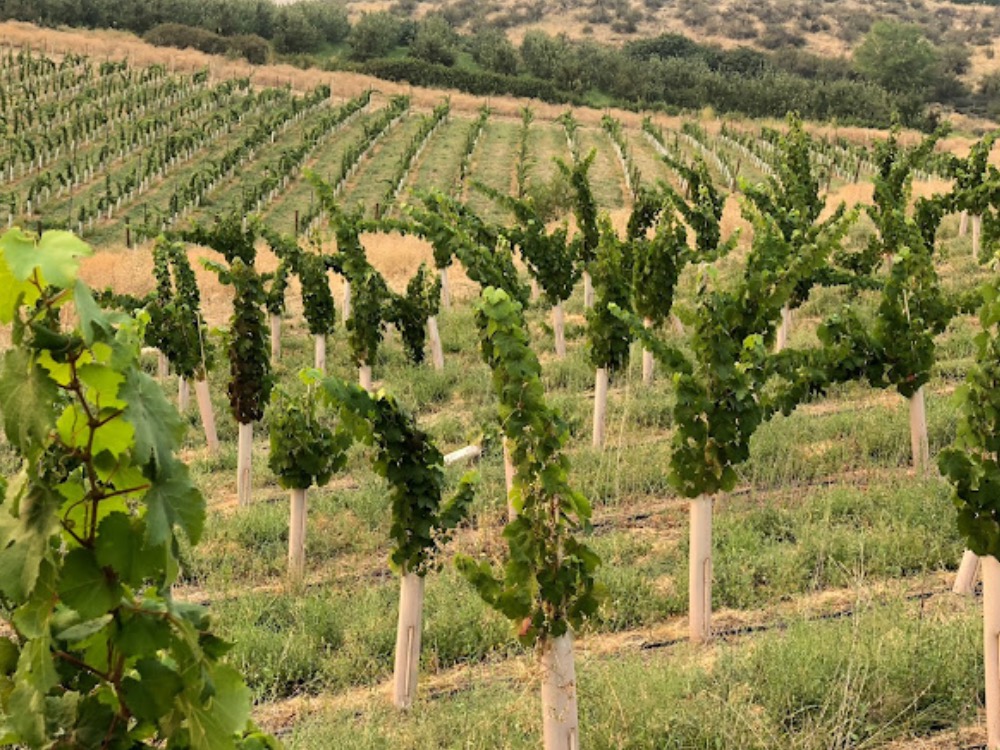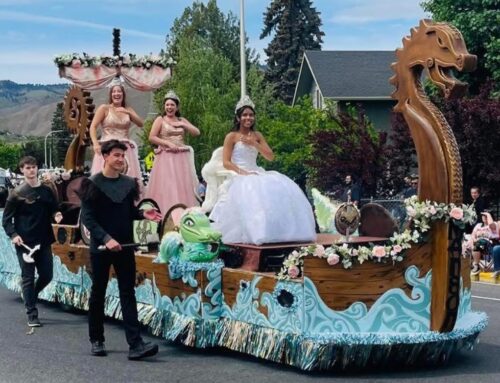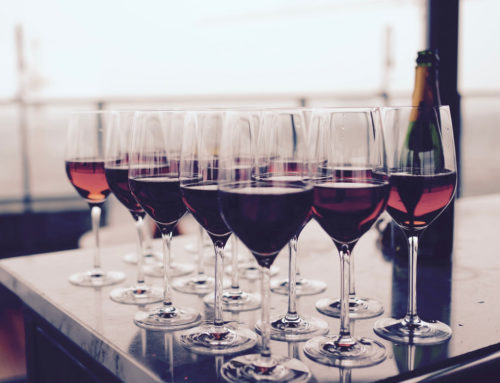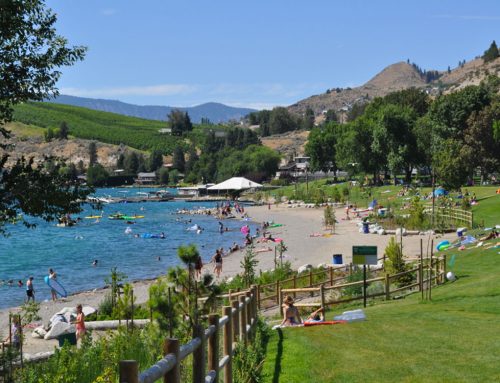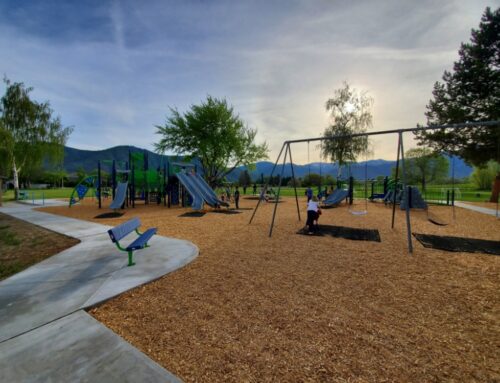An in-depth interview with Ray and Athena Sandidge
originally published by Randy Smith of The Wine Write, republished with permission
Wine on the family dinner table sparked his interest. Tutelage under master winemakers André and Dimitri Tchelistcheff helped him master his craft. In 2004, after making premier wines in Germany and at several stops in Washington State, Ray Sandidge and his wife Athena moved all of their chips in with the purchase of an estate property in what is now the Lake Chelan AVA. For the last two decades the couple has trumpeted all that is good about this picturesque wine appellation.
There’s a lot to trumpet. Unlike most other wine appellations in Washington, Lake Chelan wasn’t impacted by the Missoula Flood eight thousand years ago. Lake Chelan’s soils are the result of massive glaciers that once sat on the area. When the ice eventually receded, it left behind sandy, granitic soils. The Sandidges and their fellow Lake Chelan AVA growers are certain these soils have a positive influence on their wines.
What those glaciers also did was create a lake that spans some fifty-five miles from north to south with depths up to fifteen hundred feet. The lake effect from that huge body of water is another factor in the terroir of the Lake Chelan AVA. The lake acts as an insulator that minimizes to some extent the damage that cold Washington winters can inflict on grape vines. It’s not just a tourist attraction. It’s a difference maker.
After sampling the tasty wines in the current C. R. Sandidge Wines lineup in July, 2023, we caught up with the Sandidges recently to hear more of their story and their dedication to the Lake Chelan AVA. Enjoy the conversation.
 |
| Athena & Ray Sandidge |
The Wine Write: Ray, how did you connect with wine?
Ray: My dad was an officer in the military. As a family we were stationed in Europe for four years. I was age ten to fourteen during that time. When I was fourteen, we were visiting a city in Belgium. I was sitting at a restaurant table next to my mother. She and Dad were served this red beverage that I had never seen on a dinner table before. They were also served an appetizer that I didn’t recognize. I pestered my mom for a sip of her drink. She repeatedly told me no. I persisted, and she finally told me I could have a sip of wine if I would eat a snail. She could have said “escargot” and I wouldn’t have known what she was talking about. I recoiled at the prospect of eating a snail, but my curiosity about the beverage got the best of me. She gave me a sip, and I wound up liking both the wine and the escargot.
That piqued all of our curiosities about wine. Wine began to be served at our dinner table. Anyone fourteen years or older could have some. The teenagers only got small amounts. I developed some understanding and appreciation for wine, and how it can enhance people’s lives when consumed properly.
Later on I was a researcher at Washington State University. I did cold hardiness research on wine grapes at their facility in Prosser. That’s in the Yakima Valley. I had access to more than three hundred wine grape varieties. I asked the station manager if I could take the grapes that weren’t used in our research and make homemade wine from them. He didn’t care, so I started making wine. I’d take those wines to parties in the Yakima Valley. Unbeknownst to me, some real winemakers would be present. They all began asking who made the wine. They told me that my wines were really quite good.
I was unhappy sitting behind a desk writing research publications. It was the “publish or perish” syndrome. I handed in my resignation one day. That was thirty-nine years ago.
 |
| The legendary André Tchelistcheff |
The Wine Write: What did you do?
Ray: I got hired by what was then a small winery on the east end of Long Island, New York. It just so happened that their consulting winemaker was André Tchelistcheff. He had planned to retire that year, but he stayed on one more year. He told me he saw the fire in my belly and the passion I had for winemaking. I felt devastated when he did decide to leave, but he told me he was leaving me in good hands. His son, Dimitri, was a renowned consultant in his own right. Dimitri Tchelistcheff handled my winemaking tutoring the next two years.
So I got into wine because of my parents. I really started gathering knowledge about wine production in 1985 under the Tchelistcheffs.
The Wine Write: I know you worked in Germany after that. What brought you back to Washington State eventually?
Ray: It was always my plan to return to the United States, and specifically Washington State, to buy property, plant a vineyard, and build a winery. I returned in 1991. I was continuing to educate myself from a winemaking standpoint. In Germany I had access to all the old-time winemakers. My employer actually enrolled me at the Institute of Winemaking at Geisenheim. That school was only eight kilometers from where I lived. So I was getting a real education from a European perspective about how to make wine. I also learned how to market wine. My employer was a marketing genius.
It was always the plan to return to Washington. When I left Washington State University my goal was to get myself to the point where I could one day break away from whomever I was making wine for, and start my own winery.
I had done that research for Washington State University about cold hardiness. I had studied areas in Eastern Washington that had over fifty years of daily weather data. I collected and collated that data. I discovered that an area I wanted to live in, grow grapes, make wine, and raise a family, the Lake Chelan Valley, was well suited for wine grape growing. So it was a series of thought out decisions that brought me back to Washington.
The Wine Write: I assume you ran into some naysayers about Lake Chelan in terms of wine growing back then.
Ray: Oh, gosh yes. I was told that only Pinot Noir and Riesling might be suited. If you looked at the data to see if a variety possessed the winter hardiness to survive on a regular basis, and if the growing degree days were suitable for a specific variety, you had it made. When you compare the incidence of injurious winter temperatures, Lake Chelan Valley fares well against the rest of the state. Typically Walla Walla has some winter injuries every three to six years. That’s about the same rate for the Yakima Valley. It turns out that Chelan only has those events every seventeen years. That’s because of the lake.
Lake Chelan acts as a big heat pump in winter. When a molecule of water freezes, something called latent heat of fusion occurs. A burst of heat is released. The lake that is attempting to freeze is giving off all of this heat in the winter. Typically that helps growers here escape winter injury to our vines.
 |
| The estate Purtteman Vineyard |
The Wine Write: Tell me about finding your vineyard site in Chelan.
Ray: Athena and I made a study of it. I had been making wine in this valley since 2004. In 2015 we found a property that was suitable. We purchased it. We wanted a property within the Lake Chelan AVA boundaries. We also needed a property with its own well. We needed the quality of the water in the well to be very high. The well also had to be fairly strong. This site gave us all that. We wanted a facility that would not use chlorinated municipal water for our winemaking. This property affords us that. Finding this place involved driving around the valley looking at properties. This one came on the market, and we took the plunge.
Athena: John and Nicky Allison had owned the property. They were orchardists. I had gotten to know Nicky. She and John were well known in Manson, and very well respected. She would come into the tasting room, and we’d talk. Because this is a small town, Nicky and I shared a common friend who was a realtor. When they learned we were looking, this became a perfect fit. The Allisons had previously pulled out all their trees and put in that well. The property is a bit less than fifteen acres. It has a beautiful view of the lake, too. We were excited about that.
Ray: The property is unique in another way. The apple industry has been in the valley since the late 1800s. As a result, almost all the acreage that was in apples from then through the 1950s was exposed to lead arsenic. That chemical was applied back then to control pests. After that DDT was used for the same reason. Our site was a dry land wheat farm back then. No lead arsenic was ever sprayed on it. No DDT was ever applied on it. By the time the apple orchards were planted here, DDT had been banned. So we don’t have any chemical residues in our soils. That’s an added bonus for this site.
The Wine Write: What’s the biggest challenge for growing grapes there?
Ray: There is that occasional winter injury. We actually experienced that last year. There was a fair amount of damage throughout the appellation. Only the growers really close to the lake escaped. Because of our elevation and our proximity to the Cascade Mountain range, our growing season is compressed. It’s shortened by about ten days when compared to warmer sites in the rest of the state. We come out of spring later because of our cooler temperatures. We go into fall earlier for the same reason. Growers here need to really do their homework. You need to be sure about which varietals to plant. You need a decent chance of getting the grapes physiologically ripe in October. The rains typically start here around the twentieth of October. If you don’t have your picking done by then, it’s all over but the shouting.
The Wine Write: What did the Lake Chelan Valley wine community look like when you started?
Ray: In 2004 we had two primary wineries. Modern viticulture began here in 1998. Grapes had been planted here in the Nineteenth Century, but Prohibition put an end to all of that. Another planting happened in 1999. The two modern pioneers here were Steve Kludt and Bob Jankelson. The Benson family planted on the heels of them. We moved our operation up here in 2004. I was a consulting winemaker for Steve Kludt at that time. I was also making my wine in his facility using an alternating proprietorship agreement.
In 2005 I was called to a meeting in what is now the Vin du Lac Bistro by Kludt, Jankelson, Paul Benson, and Larry Lehmbecker. Larry owns Vin du Lac Winery. They told me that we needed to form an alliance, and we needed to shoot for an AVA. In three hours we hammered out what would ultimately become the Lake Chelan Winegrowers Association.
By 2006 there were probably thirteen wineries in the valley. Wineries like Hard Row To Hoe, Tunnel Hill, and Nefarious Cellars came on board as members of the association. I was President of the association from 2005 to 2008. By 2007 we had completed the application for appellation recognition, and had submitted it to the TTB. Alan Busacca was the geologist at Washington State University who helped guide us through the appellation process. Our membership ponied up the money to fund the effort. The Port of Chelan also contributed. The people at the Port of Chelan were a huge help to our organization in its infancy. We were awarded our AVA in 2009.
The Wine Write: What sets the Lake Chelan AVA apart from the rest of the Columbia Valley?
Athena: The big buzzword in the industry now is “terroir”. We have specific soils here, along with the lake effect Ray mentioned earlier. Those factors impact the rate of growth, along with the complexity of our fruit. We have a condensed growing season. We also have a condensed development of phenolics and color in our fruit. We get really sublime color in our red fruit. People are surprised about that. If you grow and crop a red variety correctly, you can get really dark flesh and excellent structural components. Our elevation and proximity to the Cascade range afford us deep diurnal shifts in the evenings. Most of the vineyards on the lake are on some sort of slope. The winds from the Cascades hit those slopes. Those factors help us retain malic acids. So we get lots of acidity, along with good tannins and color.
What makes the Lake Chelan AVA different are those intense structural components. The soils up here are not the basalt, alluvial byproducts of the Missoula Flood that you’ll find in other parts of the Columbia Valley. We were impacted by glaciers back then that held on above what is now Lake Chelan. They compressed those soils which are mostly granite. We also have sand, loam, and loess. This area also had a lot of volcanic activity. That impacted our soils, too.
There’s a lot of diversity between the north and south shores of Lake Chelan. Glacial activity explains some of those differences. You might think of these spots as “micro-terroirs”. They directly influence the types of grapes you can grow at each site. We are on the north shore. What we can achieve in terms of growing grapes to ripeness is different from our neighbors to the south.
The Wine Write: Are there grape varieties that work better for you at your estate vineyard?
Ray: Oh, yeah. We have had exceptional success with Malbec, as have others in the valley. Tannat is a close cousin of Malbec and a fairly obscure wine grape. It does very well for us. We just planted some Syrah. It will come to bear in 2025. Another variety that does well is an early season grape from Northern Italy called Dolcetto. It does quite well here. Our property is like a half amphitheater. It’s like half a bowl. We planted Dolcetto on a slope that faces east/northeast. That’s the coolest location in the vineyard. Dolcetto doesn’t need a lot of heat. It does better in a site that isn’t pounded with intense sunlight. It has responded exceptionally well where we planted it.
Athena: Ray makes it sound simple. A lot of expertise in the vineyard is required to make this all work. You need to know what you’re doing with the farming to grow fruit that fits the style of wine you’re trying to make. Ray is out in the vineyard, looking to see where he needs to prune, and checking to see what the vines may need. He really works to bring out the full potential of our fruit. I don’t know if I’d recommend planting Tannat everywhere in the Lake Chelan AVA, but Ray has really managed to get ours right. I’m also surprised at how well the Italian varietals are doing up here. We’ve got Sangiovese, Nebbiolo, and Teroldego planted in the valley, along with Dolcetto. Our winemakers are having a lot of fun learning about them. It’s also interesting to see winemakers figure out what works best here for a variety like Chardonnay. It can take on a lot of personalities. There are some beautiful examples of Chardonnay coming from the Lake Chelan AVA.
Ray: Our vineyard selections are based on science. Athena and I picked these varieties based on what we truly believe we can get ripe nine or ten years out of ten. We’re not interested in a grape that will only get us across the finish line with excellent quality five to seven years out of ten. We did our homework. At the same time, we also wanted to introduce grape varietals that we knew could make the style of wine we were interested in making and be different. We wanted to do some things that weren’t already being done here. The Dolcetto and Tannat fall into that category. Both have been so well received. It’s hard to keep either of those in inventory. The Tannat is one hundred dollars a bottle, and it sells out within a month. The Dolcetto is forty-five dollars, and it’s gone in a few months. Knock on wood, things have gone according to plan with those varieties.
Athena: That plays into the market. Consumers are curious. They are intrigued by how different grapes taste when grown in different places. When you find a varietal that really stands out, they remember that. People who have tasted Dolcetto or Malbec from around the world want to see how a well made one from Lake Chelan will taste. Tannat is a little more obscure. I do think as climate change progresses you will see more and more interesting grape varieties pop up. There will be some experimenting to see what varieties may get us around some of our environmental challenges. Consumer interest will be piqued by those new wines. I think we’ll see the same thing as more Tannat shows up in the marketplace. I believe a lot of Washington State winemakers and wine lovers will gravitate toward that dark, earthy, meaty Tannat. It could prove to be a good alternative to Cabernet Sauvignon one day.
Ray: Athena mentioned earlier the differences between the north shore and the south shore of Lake Chelan. There is another Dolcetto vineyard on the south shore. I was their consulting winemaker from 2017 through 2020. I had the opportunity to see what was being done in the vineyard. I got to see wine made from Dolcetto. There is quite a difference in the Dolcetto made there versus our own. Some of the difference can be attributed to vineyard management. The south shore Dolcetto got more irrigation. That resulted in bigger berries. The color wasn’t as deep, nor the flavors as rich. But it made a very nice wine. It won some awards down in California.
Our Dolcetto has smaller berries. We are really focused on our canopy management. Smaller berries increase the skin to juice ratio. You get a darker color. The grapes are more tannic, but you can control that to a degree with your skin contact and cap management through fermentation. It’s a different wine. Same variety, grown maybe five miles away as the crow flies. Elevation may differ by a couple hundred feet. Our Dolcetto is simply impactful. It’s got real substance behind it.
The Wine Write: You’ve both mentioned wine style. What style are you aiming to make at C. R. Sandidge Wines?
Ray: Athena and I learned to first enjoy wine at the dinner table. Our wines are crafted to enhance people’s lives, primarily during a dinner meal. We want our wines to interact well with the foods they are eating. This isn’t how I first started making wine. Back then I had these visions of making a fifty year red. I was going to make wines that would last fifty years! I thought people would be talking about that wine and its winemaker for centuries. I’ve since matured. We’re shooting for a red wine that hits its stride about four years after the vintage and continues to hold up really well for another eight to ten years.
Athena: We want to craft a wine that tells a story about our unique home, the Lake Chelan appellation. We’d like people to be able to tell the distinct qualities in our wines that are directly related to where it was grown. Ray’s wines are an experience from start to finish. They’re really food friendly, but delicious on their own. It’s amazing that I don’t weigh four hundred pounds…he’s such a good cook and winemaker.
Ray also makes wine from the Wahluke Slope and its well known Stone Tree Vineyard, owned by his friend Ted Wildman. Ray’s winemaking technique really centers around coaxing out what has happened in the vineyard during the growing season. His thumbprint is minimal. The style comes from the terroir of each site. It begins and ends in the vineyard. He makes a wonderful Cab Franc from Stone Tree Vineyard. His Merlot from there is absolutely glorious.
Ray: We want to respect the fruit that the vineyard brings to the game. To that end, we are not clubbing our wines over the head with a lot of new oak. We use oak as a component. Andre and Dimitri Tchelistcheff just drilled that into my spongelike brain back then. I absorbed so much knowledge from the two of them. They trained me to be able to analyze a wine with my palate. From the second the wine hit the tip of my tongue until it passed down my throat, I would analyze it. I’d look at it from a structural standpoint. My wines cannot have any gaps in the presentation. They need to be medium plus to full bodied from start to finish. There can’t be any noticeable dips in the presentation of the wine.
I asked them how I would accomplish that. That was my question thirty-nine years ago. “Blending” was their answer. I’m a big proponent of blending. We do make one hundred percent varietal reds from our estate vineyard that meet all the criteria Athena and I are looking for from a structural standpoint, bouquet, acid levels, tannin levels, and aromas. Our Tannat, Dolcetto, and Malbec are classic examples of that. That being said, I tend with red Bordeaux wines to lean toward blending. It’s a phenomenal winemaking tool used properly. That’s how André and Dimitri tutored me. They showed me how to flesh out a wine and give it the structure to make any gaps disappear.
I actually employed that discipline to some degree in Germany, where almost everything I made was Riesling from thirteen different small areas around us. One of the first things my employer did after my first vintage there was to have me taste through bagged wines from those thirteen different sub-appellations. The wines were all Riesling, grown from the same clone, and using the same yeast strain. The same fermentation techniques were used. The only real variable was where they were grown. I was stunned when I correctly called each of the wines blind. Some of the sub-appellations were only a tractor row apart. For some reason on that slope, in those particular locations, the wines were different. Whatever the Rhine River was doing centuries ago left an imprint.
I didn’t realize I had learned all that until after that session. By working with those wines and tasting them through the fermentation process, it all registered in my head and on my palate. When I started to taste them blind, they came up like a library. That all goes back to the training that the Tchelistcheffs instilled in me. I became aware of just how valuable blending could be, even within the same variety.
Athena: We just got back from Italy. We were out in vineyards near Tuscany where Sangiovese was planted all over the site. Their wines are all about the symphony of the blends of those grapes. Different terroir goes into the expressions of the final wines. That goes into what Ray is talking about in terms of blending.
The Wine Write: The Lake Chelan AVA is really still in its infancy. What’s the potential you guys see for the appellation?
Athena: We live in a recreational area. The lake draws in a lot of tourism. That’s been going on forever. Agriculture has also been present in the Lake Chelan area forever. Because of the vineyards and wineries that were here, and the recreation and tourism that the lake drew in, this area has attracted other wineries in Washington to come here and put up shop. Some of them have built production facilities, but don’t use fruit grown in the Lake Chelan AVA. In some ways those wineries have started to compete. The market has started to saturate. Ray indicated earlier how small the wine community was when the appellation was started. Now there are forty different wineries or tasting rooms, at different levels of the business, here. Some only have tasting rooms. Some are production facilities. Some use no Lake Chelan AVA grapes. Others use a combination of Lake Chelan fruit and fruit from elsewhere. Others are all in and use nothing but Lake Chelan fruit.
So there’s a real bevy of different styles of business here now. That’s precipitated a number of challenges for recognition of the AVA. The price of land over here has really increased, too. Part of that is due to the lake. We are also in pretty close proximity to Seattle. During the pandemic more people began to work remotely. A lot of them decided to leave the city. Many came to Chelan. We’ve seen a cultural shift and an economic shift in our community. That demand for land competes with people who are looking for potential vineyard sites. We are a young appellation that still faces challenges.
The potential for producing quality, distinctive fruit is obviously here. It really is a matter of passion of the growers and whether those growers have skin in the game. We have a number of wineries in the area that have installed what we call token vineyards. They don’t produce enough fruit to make wine at a commercial level. Maybe they have a five thousand case production facility, but their vineyard is only a tenth of an acre. That produces perception dissonance. Not all of the wineries are completely transparent to tasting room visitors in terms of where they source their fruit. As consumers demand authenticity, those wineries will see challenges I think.
I think we are at a liminal spot in the AVA. We are at a bottleneck because of those challenges I’ve mentioned. My passion project is to bring awareness to the growers who actually have skin in the game. We all have different ideas for rolling out that awareness. This is our home. We were raised and grew up here. We know the value of what we have here. We want to share that. We also want to protect it. It needs to be sustainable. The growers here are pushing for that. I think all of Washington is right now.
The Wine Write: Why should someone reading the story plan a wine visit to Lake Chelan?
Ray: Athena and I have been to Europe. I made wine there. I traveled all over Europe when I was making wine in Germany. I’ve been to Napa, New York State, and all around Washington. I can safely say that there is no wine appellation in the world that is as serene and naturally beautiful as this valley. Anywhere. It is stunning.
Athena: People compare us to Switzerland and Lake Como frequently. I think we’re a bit more rugged. It is Washington. Coming here is a once in a lifetime experience that should be on everyone’s list. People from all over the world come here that first time, and try their damndest to get back whenever they can. It feels sort of isolated up here in Eastern Washington, but we are only three hours from Seattle. We are truly accessible, especially during the summer season. You’ll find vineyards, beautiful lake scenery, and a laid back vibe that’s based on agriculture and small businesses. People here are helpful and friendly. Visitors relax here. People that come over the mountain pass, go through the tunnel, and get a view of the lake tell me that every cell in their body starts to breathe again. It’s a tranquil, lovely place to see.
Ray: And the wines can be quite exceptional. As the growers in the valley get a better handle on how to better grow their vines to improve the quality of the fruit, the better the wines will become. That holds true for our winemakers, too. As we all mature and understand how to better make wine, the product will just get better and better.
So we have all of this natural beauty. We have two small communities here. Manson may have fifteen hundred residents. Chelan’s population is about forty-five hundred. People here are very welcoming to agri-tourists.
Athena: Two of the wineries in our area have won Washington Winery of the Year recognition. They are Chelan Cellars and Mellisoni Vineyards. That’s really saying something. They were seen as the best of the best in Washington State. So we are a world class destination with world class wines. We welcome people to come see for themselves!
That’s an invitation we wholeheartedly endorse. The vistas you will see on the way to Lake Chelan, and the beauty you’ll be immersed in once you get there, are breathtaking. We’ll add that the hospitality we experienced at each of our stops was top notch. There’s no snootiness, just down home friendliness.
Lake Chelan does provide great water recreation, golfing, and shopping. There is certainly a lot of foot traffic in the summer. The number of tasting rooms popping up in the area shows recognition of that fact. Athena and Ray Sandidge, and lots of other growers there, are quick to point out that that’s not all there is.
Wine quality from fruit grown from within the Lake Chelan AVA continues to ramp up. This is an appellation in its infancy. Growers are still experimenting. They’re learning which varieties do best at each site. Winemakers are still tinkering with how best to approach the home-grown fruit in order to show Chelan’s terroir. Based on what we sampled last summer, they’re gaining on it. There’s quality wine coming from the lake.
The word hasn’t fully gotten out yet. If you’re searching for a wine region to explore, that fact inures to your benefit. Fly in to Seattle, Portland, or Boise and drive amongst some of this country’s most picturesque landscapes. The journey always puts me in the mind of purple mountain majesties and amber waves of grain. Make your way to downtown Manson, Washington to taste Ray Sandidge’s wines. He learned from masters. With skin in the game, he and Athena are now determined to show the goodness inherent in the Lake Chelan AVA. It’s a stop you’ll savor.


